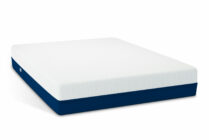A good night’s sleep is one of the most effective ways to boost your physical and mental health. Choosing the right mattress is key to sleeping better at night, especially for those with certain health problems. Hypermobility, a common condition that makes your joints ache because they’re overly flexible, can affect your sleep quality. We’ll help you choose an orthopedic mattress for hypermobility in this article.
When choosing an orthopedic mattress for hypermobility pain, purchase a medium-firm memory foam or latex orthopedic mattress with targeted support areas that provides pain relief for flexible joints.
3 orthopedic mattresses recommended by doctors
If you have super flexible joints with an unusually large movement range that cause severe pain, this article will help you find the right orthopedic mattress to relieve your symptoms while resting during the day or sleeping at night. Read our article on the 7 benefits of orthopedic mattresses to find out more about their pain-reducing capabilities.
What Is Hypermobility? Can Orthopedic Beds Help Hypermobility Symptoms?
Hypermobility syndrome is characterized by joints that move beyond the normal range of motion. Hypermobility is often caused by ligamentous laxity, a condition that occurs when ligaments are too loose.
Hypermobility is a connective tissue disorder that affects the joints and ligaments. Symptoms include fatigue, pain and stiffness in joints or muscles, joints that keep dislocating, poor balance, and digestive problems. Using an orthopedic mattress can help reduce pain and stiffness, by providing superior support for affected joints and muscles.
The specific term for joint hypermobility is Ehlers-Danlos syndrome-hypermobility type (JHS/EDS-HT). Ehlers-Danlos syndromes include connective tissue disorders that can be inherited. However, according to this article from The Ehlers Danlos Society, the cause of hypermobile EDS is unknown.
According to this article from the Cleveland Clinic, hypermobility typically makes your joints overly flexible but does not cause any pain or medical complications in the majority of patients. However, some people may still experience joint and ligament pain, injuries, fatigue, or other unpleasant symptoms that affect sleep quality. Patients with hypermobile joints who experience pain or discomfort while sleeping require a more customizable bed to get a good night’s rest. An orthopedic mattress offers a slightly firmer sleep surface while providing targeted support for different body parts. Our article about orthopedic mattress layers discusses the multi-layered construction that provides superior support to aching joints.
Symptom 1. Constant Fatigue, Even After Resting
A variety of health problems can cause fatigue, hypermobility is just one of them. Having hypermobile joints can lead to patients getting tired, even after resting. However, since lots of different things cause fatigue, feeling tired does not necessarily mean that you have hypermobility. It’s best to get a diagnosis from your doctor.
If your constant tiredness is caused by joint hypermobility, you should consult a physical therapist and obtain a detailed program to strengthen your joints. Lack of good quality sleep can worsen fatigue in patients with hypermobile joints. Patients with joint hypermobility syndrome (JHS) can relieve symptoms (such as fatigue) with certain sleep strategies. Individuals with hypermobile joints should set consistent bedtimes and select the proper orthopedic mattress. Read our orthopedic mattress price guide for tips to help you choose the right one.
Although there is not a single orthopedic mattress type that can minimize tiredness in patients with hypermobility, you can still select the one that suits your needs. For example, an orthopedic mattress that is well ventilated will help prevent bed sores which are one symptom of hypermobility, as described in this article from the Journal of Nursing Education and Practice. Depending on how soft, firm, or thick you want your orthopedic mattress to be, you can easily select the suitable material and density. To learn more about orthopedic mattress materials, check out our article.
Symptom 2. Joint or Muscle Pain and Stiffness
According to this article from Healthline, hypermobility sometimes leads to pain and stiffness in joints during or after movement. If this is the case, you should focus on relieving pain and strengthening joints. Consult a doctor before using prescription or over-the-counter creams, sprays, or pain relievers.
You can also relieve joint pain by using the right orthopedic mattress. When it comes to proper spine alignment and support for your body, an orthopedic mattress like this is a better choice. Most orthopedic mattresses are made from memory foam, latex, or innerspring coils. Each mattress type is designed to promote neutral spine alignment so that your spine maintains a natural curvature. While we all tend to bend forward during the day, this might be even more relevant to individuals with certain joint issues. Good posture is essential for maintaining natural spine curves, according to the Mayo Clinic, and orthopedic mattresses can definitely help you keep your spine properly aligned while sleeping.
In addition, orthopedic mattresses provide support for your joints and muscles that promote pressure point and pain relief. While hypermobility does not always make your joints stiff, some might still experience mild or even severe joint and muscle pain. Sleeping on an orthopedic mattress ensures that your body gets enough support to reduce pain and sleep peacefully. Take a look at this group for EDS and HSD patients, where a patient recommended a 100% latex foam mattress topper like this one which he has been using for 30+ years for joint pain. To learn more about how orthopedic mattresses align the spine, read our article comparing orthopedic mattresses vs. regular ones.
Symptom 3. Poor Balance and Coordination
As hypermobility makes joints and ligaments too flexible, patients often experience poor balance and coordination. This research paper published by PubMed mentions that subjects with hypermobility showed significantly impaired balance and 95% of the patients either fell or were afraid of falling during the modified clinical test of sensory interaction on balance.
While appropriate exercise programs could strengthen joints in patients with hypermobility, selecting the right sleeping surface is also essential. Tempurpedic mattresses like these are commonly recommended on HSD forums by patients.
Symptom 4. Gastrointestinal Involvement and Digestive Issues
As highlighted in this paper published by PubMed, gastrointestinal involvement and nutritional issues are well-known complications of Ehlers-Danlos syndromes, and the hypermobility type is the most studied one.
Stress can lead to or even worsen a variety of gastrointestinal problems, so patients with hypermobility should keep their stress levels down. This can be done by having a good sleep routine and using a supportive orthopedic mattress. Read our article about flippable orthopedic mattresses to learn more about how they can help with good quality sleep.
Tips to Find The Best Orthopedic Mattress For Hypermobility Syndrome
If your doctor diagnoses you with hypermobility, you should consider an orthopedic mattress for hypermobility and protect your joints.
To find the best orthopedic mattress for hypermobility, choose a medium-firm mattress made from memory foam or latex with a gel-infused comfort layer for improved temperature regulation.
Simple things, such as using an orthopedic mattress, can help your condition by relieving pain, promoting proper posture, improving your spine alignment, and making you feel comfortable while resting or sleeping. Read our article about orthopedic mattresses that are covered by medical insurance to see whether you could qualify for reimbursement should you have a doctor’s prescription for an orthopedic mattress.
Tip 1. Choose an Orthopedic Mattress Made from Memory Foam or Latex
Generally speaking, this memory foam and these latex orthopedic mattresses are best for those who suffer from hypermobility. These two are made from materials that provide enough support and pressure point relief to minimize pain and optimize sleep quality in patients. As outlined in this article from the Journal of Manual Therapy, a patient with a very firm memory foam pillow and orthopedic mattress had reduced pain in the lumbar region compared to others.
While innerspring orthopedic mattresses like these are still widely used across the globe, they are not helpful when it comes to having hypermobility in joints. Memory foam and latex mattresses work much better because they are designed to contour the body, relieve pain, and isolate motion. These are the kind of features you should be looking for in an orthopedic mattress. Read our article comparing orthopedic mattresses vs. spring mattresses for details about their similarities and differences.
Although both memory foam and latex mattresses are suitable for patients with hypermobility, there are some differences to take into account before making a choice. First, memory foam offers enhanced contouring, while latex mattresses feature moderate contouring. Latex mattresses are characterized by excellent bounce and durability, while memory foam orthopedic mattresses are better at motion isolation, making them an ideal option for couples.
Tip 2. An Orthopedic Mattress with Medium Firmness Helps Support the Spine while Softer Mattresses Offer Pain Relief
Typically, medium firmness is good for those who deal with hypermobility. Whether it is a memory foam or latex orthopedic mattress, a medium-firm feel will provide sufficient support for your spine. This is especially beneficial for those who experience posture, balance, and coordination problems.
Medium-firm orthopedic mattresses like these also help to keep your spine properly aligned while sleeping. This will reduce the risks of further complications linked with hypermobility and flexible joints.
If you suffer from joint pain or stiffness, you should consider getting a slightly softer orthopedic mattress like this. While medium-firm mattresses also provide pain relief, firm options should be avoided as they may worsen your symptoms. The key here is to find an orthopedic mattress that is neither too firm nor too soft. Even if you are looking for a mattress for pain relief, you still want to keep your spine supported while sleeping. So, medium or medium-firm orthopedic mattresses would be ideal for people with hypermobility. Read our article that provides tips to choose an orthopedic mattress for elderly sleepers which goes into greater detail about the merits of choosing a medium firmness level.
Tip 3. Go For an Orthopedic Mattress with Cooling Properties To Reduce the Risk of Ulcers, Especially For Overweight Patients
As patients with hypermobility often experience fatigue and constant tiredness, it is crucial to keep them as comfortable as possible, especially while sleeping. If you’re a hot sleeper or overweight, getting a good night’s sleep is also linked with temperature regulation. An orthopedic mattress with cooling features would solve the issue. Read our article about choosing an orthopedic mattress for a heavier person for tips to help you choose the right one.
Modern orthopedic mattresses often include a gel-infused layer that provides enhanced temperature regulation. This prevents sleepers from getting too hot while resting or sleeping on the bed. Getting a gel-infused memory foam orthopedic mattress, like this would promote better sleep quality for hot sleepers and overweight patients struggling with joint hypermobility.
Tip 4. Think of Your (and Your Partner’s) Preferred Sleeping Position
If you suffer from hypermobility then you should also consider your preferred sleeping position when choosing an orthopedic mattress. If you are a side sleeper, consider getting a softer orthopedic mattress like this. If you prefer sleeping on your back or stomach, relatively firmer orthopedic mattresses like these would be suitable.
If you sleep with a partner, you should consider selecting an orthopedic mattress that offers motion isolation. While memory foam mattresses provide little to no motion transfer, latex mattresses do not isolate motion nearly as well. Therefore, a memory foam orthopedic mattress with medium firmness would be ideal for couples.
Tip 5. Using a Suitable Mattress Topper is a Budget-Friendly Alternative
If you are on a tight budget, you could also consider getting an orthopedic mattress topper as a more affordable alternative. This option would also help with a variety of hypermobility symptoms and you will not have to spend extra money on an orthopedic mattress.
This 3-inch medium-firm mattress topper is an ideal option for those who want to relieve joint pressure and muscle tension. It offers personalized comfort and support that promotes better sleep quality for people with hypermobility. You can find additional tips and recommendations on how to choose the right one in our simple mattress topper density guide.
Tip 6. Do Not Forget to Consult a Healthcare Professional First
While the tips discussed above can significantly improve your sleep quality, consulting a doctor is essential to ensure that you do in fact, have hypermobility. The fact is that hypermobility sometimes mimics arthritis and other more serious inflammatory conditions. If this is the case, you may need to undergo proper tests to verify your diagnosis.
If you have been diagnosed with joint hypermobility, you still need to schedule an appointment with a physical therapist for additional recommendations and guidance. Getting professional help is essential for patients with hypermobility, to improve their movement and manage pain. This will ensure that patients receive adequate preventive care, rehabilitation, and treatment based on their condition.
Choosing An Orthopedic Mattress For Hypermobility – A Summary
| Hypermobility Symptom | What Type Of Orthopedic Mattress Is Best and What Features Should You Look For? | Example of an Orthopedic Mattress from Amazon | Price |
| Fatigue | A memory foam orthopedic mattress that is neither too soft nor too firm. | Olee Sleep 10-Inch Aquarius Memory Foam Mattress – Medium Firmness | ~$225 |
| Joint Pain and Stiffness | Relatively softer memory foam mattress for pressure and pain relief in joints and muscles. | Lucid 8-Inch Memory Foam Mattress – Plush Feel | ~$205 |
| Poor Balance and Coordination | A medium-firm latex orthopedic mattress to promote proper spine alignment. | Lucid 10-Inch Responsive Latex Hybrid Mattress – Medium Firmness | ~$370 |
| Gastrointestinal Involvement and Digestive Issues | Choose a medium-firm memory foam mattress which is generally the best for all-around comfort. | Zinus 8-Inch Ultima Memory Foam Mattress – Medium Firmness | ~$220 |
Aside from hypermobility, you might be wondering if orthopedic mattresses work in general. You can find the answers to all of your questions in our detailed guide. Be sure to take a look for more information.
Key Takeaways
Identifying the Right Material
Choosing an orthopedic mattress made of medium-firm memory foam or latex is crucial for those with hypermobility, as these materials provide targeted support areas aiding in pain relief for overly flexible joints.
Customized Support
Orthopedic mattresses with targeted support areas are key in providing relief from hypermobility symptoms. They offer superior support to aching joints and muscles, promoting a neutral spine position which is instrumental in reducing joint pain and ensuring a comfortable sleep.
Temperature Regulation
For optimal comfort, especially for hot sleepers or overweight individuals, opting for an orthopedic mattress with cooling properties like a gel-infused layer is essential. This feature aids in temperature regulation, promoting better sleep quality.
Sleep Position Consideration
Taking into account your preferred sleeping position is vital when selecting an orthopedic mattress. For side sleepers, a softer mattress is preferable, while back or stomach sleepers may find relief with a firmer mattress. Moreover, if sharing the bed, a memory foam mattress is ideal for its motion isolation feature.
Budget-Friendly Alternatives
If on a tight budget, considering a medium-firm orthopedic mattress topper is a viable alternative. It provides a level of comfort and support that alleviates joint pressure and muscle tension associated with hypermobility, without the need for a full mattress investment.
Professional Consultation
It’s imperative to consult with healthcare professionals to confirm a hypermobility diagnosis and receive tailored advice on managing symptoms. Additionally, seeking guidance from a physical therapist for a detailed joint strengthening program can be beneficial in alleviating symptoms related to hypermobility.
Exploring Recommendations
Investigating and considering doctor-recommended orthopedic mattresses can provide insight into reliable options that cater to hypermobility needs, ensuring a well-informed decision for improved sleep quality and symptom alleviation.



